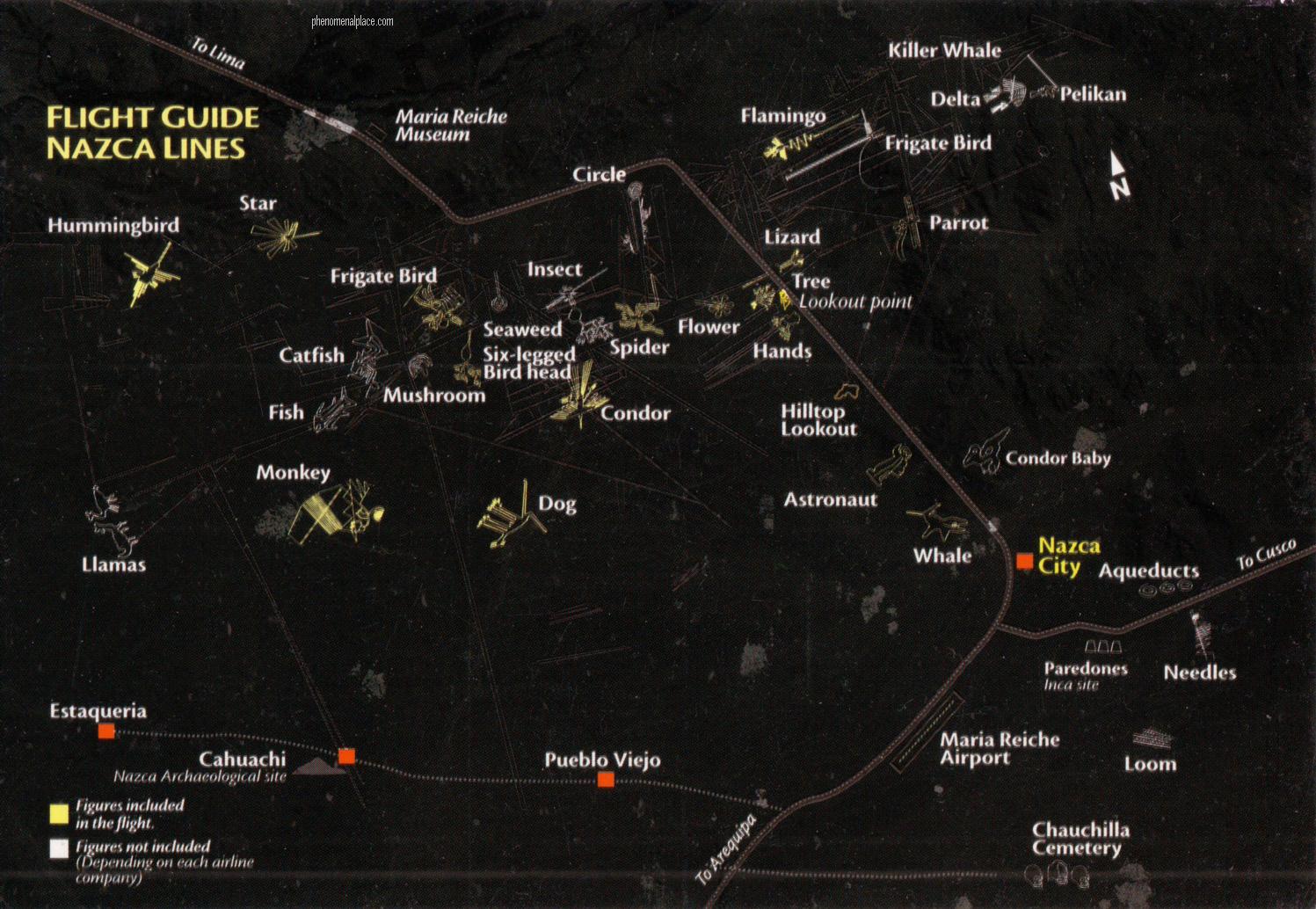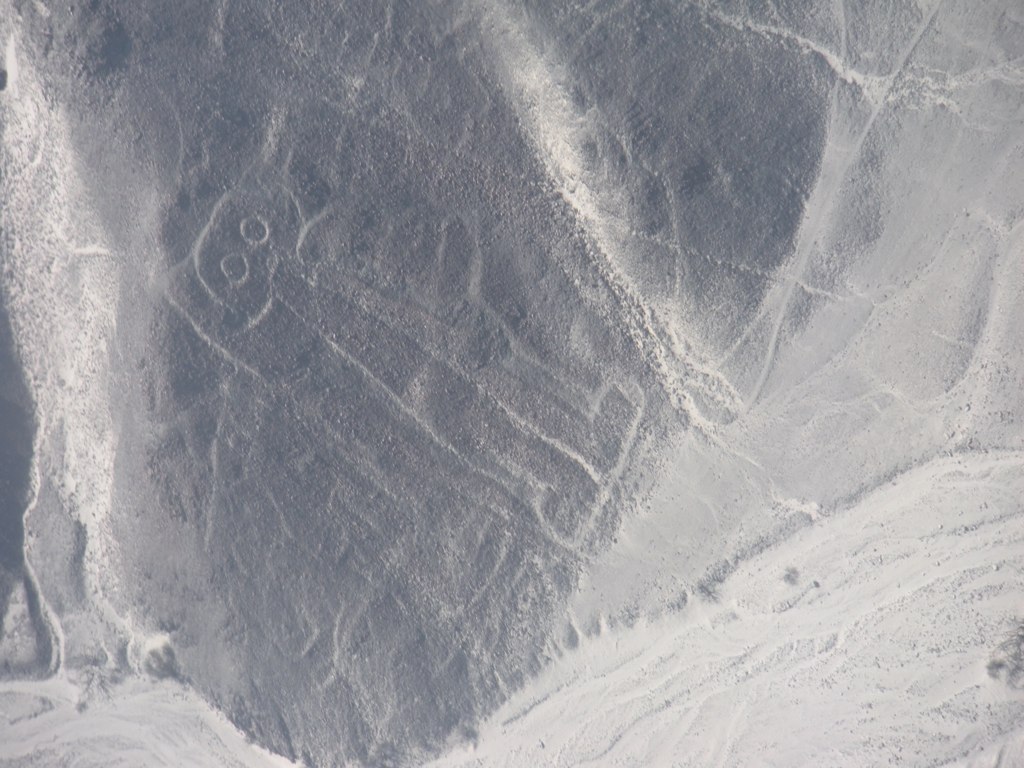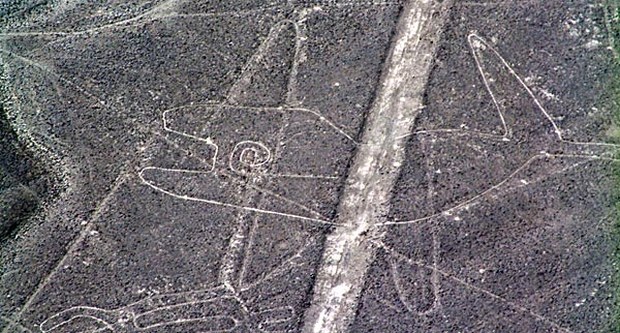Giant geometric shapes, enormous animal figures and ruler-straight lines extending to the horizon: why these impressive markings are etched into the bare grassless soil of a remote region of Peru is one of the greatest mysteries of all time. Some 2000 years ago, a South American civilization about which very little is known created some of the most puzzling inscriptions on Earth. Peru’s Nazca Desert resembles pages from a giant’s sketchbook.
The red desert rock has been etched with more than 100 designs, ranging from familiar plant and animal forms to geometric patterns and strange series of straight lines. Theories abound as to what they were supposed to represent and why they were drawn at all, yet their true purpose, if they have one, remains a complete enigma.
The largest work of graphic art in the world covers an area of 200 sq. miles (520km) in Peru between the Andes and the Pacific Ocean. Scant reference to the Nazca lines was made by 16th and 17th-century Spanish explorers, but they remained largely unknown to the outside world until the 1920s, when Julio Tello, the so-called father of Peruvian archaeology, first recorded the designs.
The patterns did not become the subject of serious investigation until 1941, when the American historian Dr. Paul Kosok, from the University of Long Island, went to Nazca. In 1946, Kosok handed on his information to the German mathematician and astronomer Dr. Maria Reiche (1903-1998) who spent the following 50 years living on the Nazca Plain, protecting, charting and recording the inscriptions and attempting to explain their significance.

The drawings on Nazca’s desert floor were all made in the same way: by scraping away the reddish gravel on the surface of the desert to reveal the pale yellow rock beneath. This appears to have been done by hand – at least, there is no evidence of the use of animals – and in such a way that, regardless of shape, size or subject, each image is made up of a single, uninterrupted line.

Little rain falls in the Nazca region, so the majority of drawings have remained as fresh and new as when they were made. Many of the figures are huge: the spider, for example, is 148ft (45m) long. The monkey figure has been interpreted as symbolizing the rising of Benetnasch, a star of the Plough constellation, in AD 1000. Hummingbirds are common on Nazca ceramics, and often appear in the markings; the whale is the only marine creature.

A nectar-eating hummingbird extends its long thin beak to reach dead-straight lines that extend to the horizon. The bird appears to have been connected to the grid lines at some time, although the point of contact has been obscured by scuff marks over the years. Car tracks have also erased some of the grid lines.

The body of the snake-headed bird is that of a hummingbird. But the long sinuous neck resembles a serpent as it snakes its way across the desert. One suggestion is that the creature, like the other animal figures, is intended to represent a constellation or another of the heavenly bodies revered by the Nazca Indians.
There are more than a dozen birds and bird-like animals in the Nazca designs, the majority composed solely of straight lines. The toucan in flight is an exception: here the artists used curved lines, which are more common in the plant and animal images.
Many of the pairs of lines resemble landing strips. Suggestions that they were intended for spaceships have been discounted, however – not least because the desert soil could not support the presumed weight involved.

In the 1970s the American explorers Julian Nott and Jim Woodman tried to prove that the people who made the designs could have seen them from the air. They built Condor I, a hot-air balloon, using only the materials which would have been available to the Nazcans.

The subjects of the Nazca inscriptions fall into two broad categories: figures and lines, the latter of which are arranged either in pairs like tramlines or conceived as geometric patterns. And, since in many places lines are etched over figures, the figures were clearly made first. Among them are the leaves and branches of various plants; animal and bird figures; and strange combinations of two different forms. These include the figure of a man with the head of an owl and a bird with an over-long serpent in place of its beak.

The lines themselves are so straight that it seems likely they were set out using a series of poles aligned by eye. Yet one of the mysteries is how the builders managed to maintain such alignment over the distances involved: some lines deviate by less than 10ft per mile (2m per km) over distances of more than 5 miles (8km). in many places, series of lines fan out from a single point in all directions, formations that Maria Reiche called starlike clusters. Often lines crisscross one another in an apparently random way to form giant rectangles and triangles.

The Nazca inscriptions appear to date from between 500 BC and AD 500; they were probably made by the Nazca Indians who inhabited areas of Peru before the rise of the Inca Empire. The Nazcans were farmers who cultivated the fertile plain along the Pacific coast of Peru. These people left no evidence of a written culture: all that is known about them comes from studying their burial places and grave goods. The dead were interred in the foetal position, surrounded by multicoloured pottery and other artefacts, but many of the burial grounds, some of which contained up to 5000 graves, have been robbed.
This fragmentary knowledge of the Nazcans does not explain why they etched these patterns in the desert. One supposition was that they were ancient highways, but this is unlikely since many end abruptly on the top of hills. The most widely accepted hypothesis was proposed by Dr. Paul Kosok, who believed that the figures and lines represented ‘the largest astronomy book in the world’. His view was shared by Dr Reiche. She suggested that they predict the positions of stars and constellations at various times of the year and were used to determine the seasons for sowing, harvesting and so on. The beaks of some of the bird forms, for example, are aligned with the position of the sunrise at the summer solstice.
The fact that the lines can only be fully appreciated from above has prompted the theory that the Nazcans were able to fly, or at least hover above ground while the lines were being constructed. While this fascinating idea is not wholly far-fetched – paintings on pottery show objects that bear some resemblance to both kites and hot-air balloons – it still does not explain why these lines were made in the first instance.
-end-




































